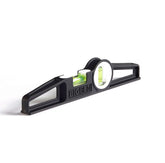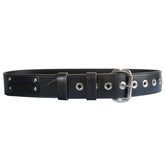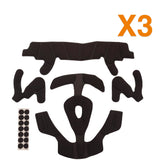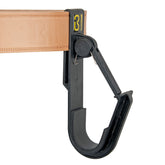Trees are the beating heart of our planet.
Their benefits are plentiful. A tree soaks up carbon dioxide as it grows, helping slow the rate of global warming. That’s why we’re planting more of them.
Trees also boost wildlife and provide safe havens for all sorts of amazing living things, from birds and insects to fungi.
They’re pretty important for our mental health, too. As we all spend more time locked into our screens, venturing out into the countryside or to a local park for some much-needed fresh air provides a welcome relief from our fast-paced modern lives.
But trees need specialist care. And delivering this care is often dangerous work.
According to the Health and Safety Executive (HSE), falls from height are one of the major causes of workplace deaths and major injury. Many of these incidents occur when working with trees.
Furthermore, the HSE estimates 16% of all reported tree work accidents involve a fall from height. To combat this risk, it’s imperative we empower arborists and tree surgeons like you to operate safely by arming your team with best-practice safety advice, and market leading height safety equipment, so you can work with confidence.
What are the risks?
There are plentiful risks arborists and tree surgeons face on a day-to-day basis when working at height. These include:
Falls from height
Working at height is risky enough as it is. Add to the pot some potentially weak branches or rotted wood, and the risk of a fall is significantly increased. If the tree is old and unable to withstand your weight, or you can see potential weak points and high-risk areas, it’s important the right safety measures are implemented before any work takes place.
It may also be beneficial to find an alternative solution to thinning or trimming in a certain area. If you do continue as planned, using the correct height safety equipment is vital.
Ladders
Ladders may seem like an obvious choice to reach the upper reaches of a tree. But what you gain in simplicity you may lose in safety if due care isn’t taken. One wrong move without the correct gear could see you or your ladder falling.
Solo working
Working solo may be better for the budget, but if an accident does occur it may leave you stranded without the required medical assistance readily available.
How to work with trees safely
Before any project, it’s important to undertake a thorough review and assessment which takes into consideration any risks you might face, so you know what safety measures to deploy.
Trees can be fragile. To protect yourself, it’s important to treat them with respect. Here’s what to do:
Check the weather – This is a common piece of advice we often give to tradespersons working at height. No matter the industry, if a storm comes and you’re subjected to severe wind and rain, the risks drastically increase. Best to leave some jobs to another day.
Inspect the tree - Tree branches become more delicate the higher we climb. Always inspect the tree before you start. Be aware of any weakness or damage to ensure it’s safe to climb that particular tree, or to certain heights.
Older trees can be particularly tricky to navigate. Age, as well as moss or plants, mean parts of a tree can be weaker than it looks. A thorough tree inspection is a necessary first step before any tree work.
Follow HSE guidelines - For every task that demands work at height, you need to assess the risk and put suitable control measures in place. The HSE advise that the Work at Height Regulations 2005 should be followed for all work at height[1]. It is the duty of the employer and/or contractor to ensure that any work at height is:
- Properly planned and organised – including planning for emergencies and rescue
- Assessed for risks using a hierarchy of control measures
- Appropriately supervised
- Done in a way that is – as far as is reasonably practical – safe
- Always done by competent people, including managers and supervisors, who are appropriately trained and supervised
- Done using equipment that is regularly inspected and maintained
- Keeping up to date with HSE and industry guidance to ensure you continue to meet your duties under the Work at Height Regulations
Always wear appropriate PPE - For all those working at height, including arborists and tree surgeons, wearing the correct PPE is essential. A height safety helmet should be a priority, as this will protect your head in case you fall from a tree, and shield you from anything falling from above, including branches.
Introducing the BIGBEN® Ultralite Height Safety Helmet. Its outer shell is made from high-density ABS plastic to withstand impacts from above or the side. It also conforms to the EN12492 Standard and EN397 Industrial Standard for shock absorption and penetration. It’s the perfect helmet for arborists working at height.

Don’t climb in close proximity to power lines - An important point – if your arborist rope touches a live power line, you might electrocuted. This is incredibly dangerous. Make sure you thoroughly inspect the area so you’re confident there are no live powerlines in the vicinity.
Deploy specialist arborist equipment - Much of what we can do to improve arborist safety is deploying common-sense principles. Think tree inspections, safety assessments, rescue planning and following the correct guidelines. But we can also take advantage of specialist arborist equipment to improve safety.
Champion Gear Arborist Harness

Champion Gear has pioneered a male arborist harness you can trust. It features ergonomically designed backlog and shoulder pads and can be used for fall arrest, work positioning, descent and sit applications. It also conforms to EN 813:2008 & EN 358:2002.
Work in teams - If you’re working alone and an accident does happen, there may not be anybody around to offer medical assistance. If possible, always try to work in teams. Safety in numbers.
Protect your team with arborist safety equipment from Leach’s
We all know that working at height, especially on trees, is risky work. We must understand what those dangers are in order to effectively mitigate against them.
Arborists and tree surgeons that excel at implementing stringent safety measures when working with trees, and who choose the most appropriate arborist safety equipment, will be successful in reducing the risk of injuries to workers. Explore Leach’s range of arborist safety equipment now, or contact our sales team on 01432 346890 for further guidance.
*This is not a complete guide. We always recommend speaking to a competent and trained height safety specialist before undertaking any work at height.
[1]https://www.hse.gov.uk/treework/safety-topics/height.htm


















